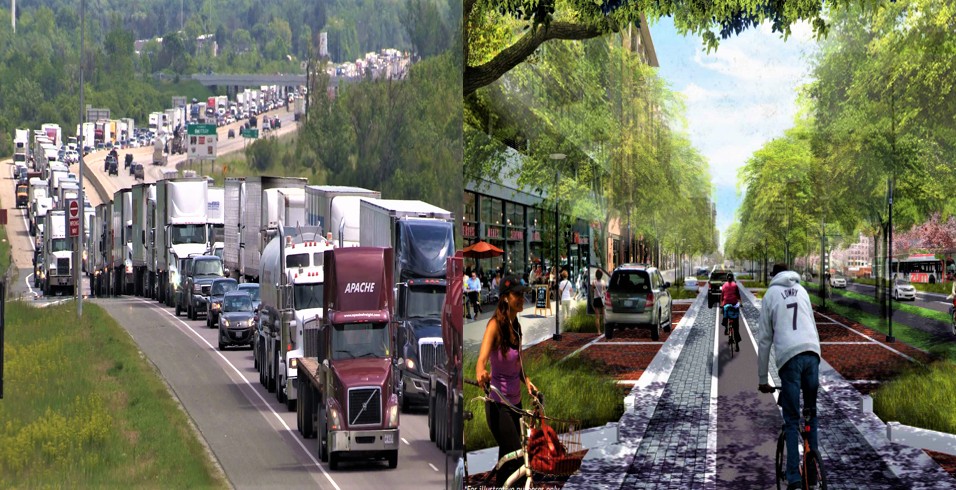
Sprawl and commercial trucks or complete communities: Why is Brampton’s plan for the massive development of its western side so different than the province’s?
Last week the City of Brampton issued a press release championing an urban plan for the booming suburb’s “last undeveloped area: Heritage Heights.” What it failed to mention is the proposal for the 4,000 acres along the western portion of the municipality, which would house enough people to be considered a large city in most provinces, is not “compatible” with Queen’s Park’s plan for the GTA West corridor that will dominate the entire area.
After the proposal for a complete communities concept for Heritage Heights, including a grand boulevard design instead of a highway along the province’s planned mega-transportation corridor, was put forward by staff earlier in the year, on August 5, Brampton City Council approved the dynamic plan.
If followed, it would be the last major urban growth plan in what is currently undeveloped greenfield land inside Brampton’s municipal boundary and would represent the most significant accommodation for the estimated 300,000 new residents who will arrive in the city within the next three decades.
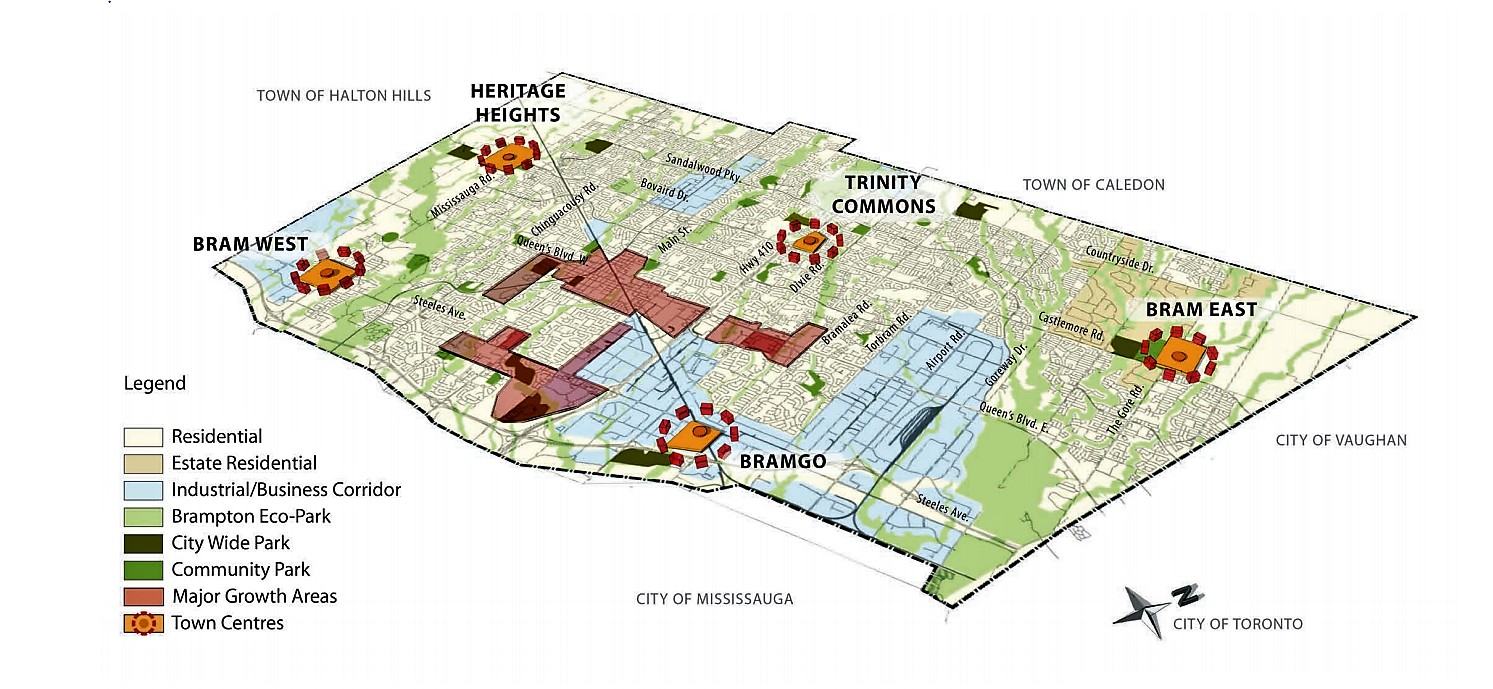
Heritage Heights as identified in Brampton's 2040 Vision master plan for smart growth
The province has ultimate authority over the 400-series project and it can override any municipal plans that are not compatible with its transportation objectives.
The area known as Heritage Heights makes up about 17 square kilometres (five times the size of New York City’s Central Park) of the city’s total land mass and is the final development frontier for Brampton.
For a city often criticized as being planned by developers who built sprawl for more than three decades, Heritage Heights represents a modern way of thinking, driven by sound growth principles and considerations for smart transportation and environmentally responsible design.
Central to this approach was a bold decision by the City to eschew the traditional 400-series highway design that frames Brampton and fueled much of the sprawl, spread-out subdivisions and vast swaths of warehouses and low-density industrial spaces along the major transportation corridors. Instead, Heritage Heights represents a break from so much of what has defined Brampton over the last three decades, when it transformed from a bucolic historic village to an industrial patchwork of low slung factories, plants and strip malls, with cookie-cutter subdivisions that sprang up in between.
In keeping with the city’s master plan for future growth, the 2040 Vision, approved by Council as the guiding principle for Brampton’s new direction, the boulevard concept sounded like an ideal way to preserve the bold new strategy. Instead of a clogged 400-series mega-highway, whose asphalt runway through the western part of the city would be the width of almost two football fields, with massive spaces for on and off ramps and hundreds of more metres on either side required for highway infrastructure features, the boulevard concept would not cut off the city and lead to more sprawl. It allows for the creation of vibrant, complete communities, mixed uses, pedestrian traffic along busy high streets featuring dense residential dwellings and a wide range of retail, dining and employment options along with other community services.
Early concepts earmarked Heritage Heights for a new hospital, GO station and two dynamic “Town Centres” in and near the area.
The City’s press release last week, announcing Council’s approval of the plan, described it as a “new Town Centre – a complete, full-service, mixed-use place with work and housing options. The concept plan for Heritage Heights reflects best practices for creating a community where future residents and employers can enjoy a healthy lifestyle and high quality of life. It is based on extensive community engagement, and sets the framework for a sustainable, livable, vibrant, and healthy place to live, work, learn and play.”
On the same day, the Government of Ontario, led by Premier Doug Ford, announced something entirely different. The route for its planned 413 GTA West Highway, had been selected and plans to move forward with a massive transportation corridor that had been scrapped by the previous Liberal government now appear unstoppable.
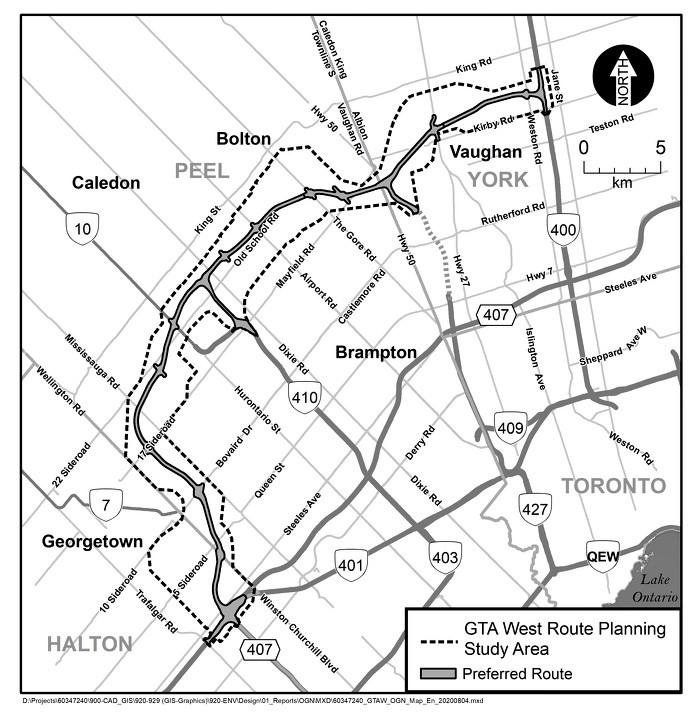
Last week, the province announced the route for the GTA West Highway, which will cut right through Heritage Heights
The selected path runs right through the middle of the Heritage Heights area, between Mississauga Road and Winston Churchill Boulevard.
The province and other proponents of the GTA West highway have made clear that goods movement is a priority for the PC government’s plan to build the 413, which will run from Milton, up the western end of Brampton, into Caledon where it will turn east just above the border of the two municipalities and extend all the way into Vaughan.
Heavy commercial transport truck use is expected, and the highway will be much like other corridors built largely to move goods through the province. This is completely incompatible with the City of Brampton’s 2040 vision and will admittedly lead to more sprawl, instead of smart growth meant not only in Heritage Heights but in other identified urban growth areas, such as the Queen Street corridor across the city’s struggling downtown.
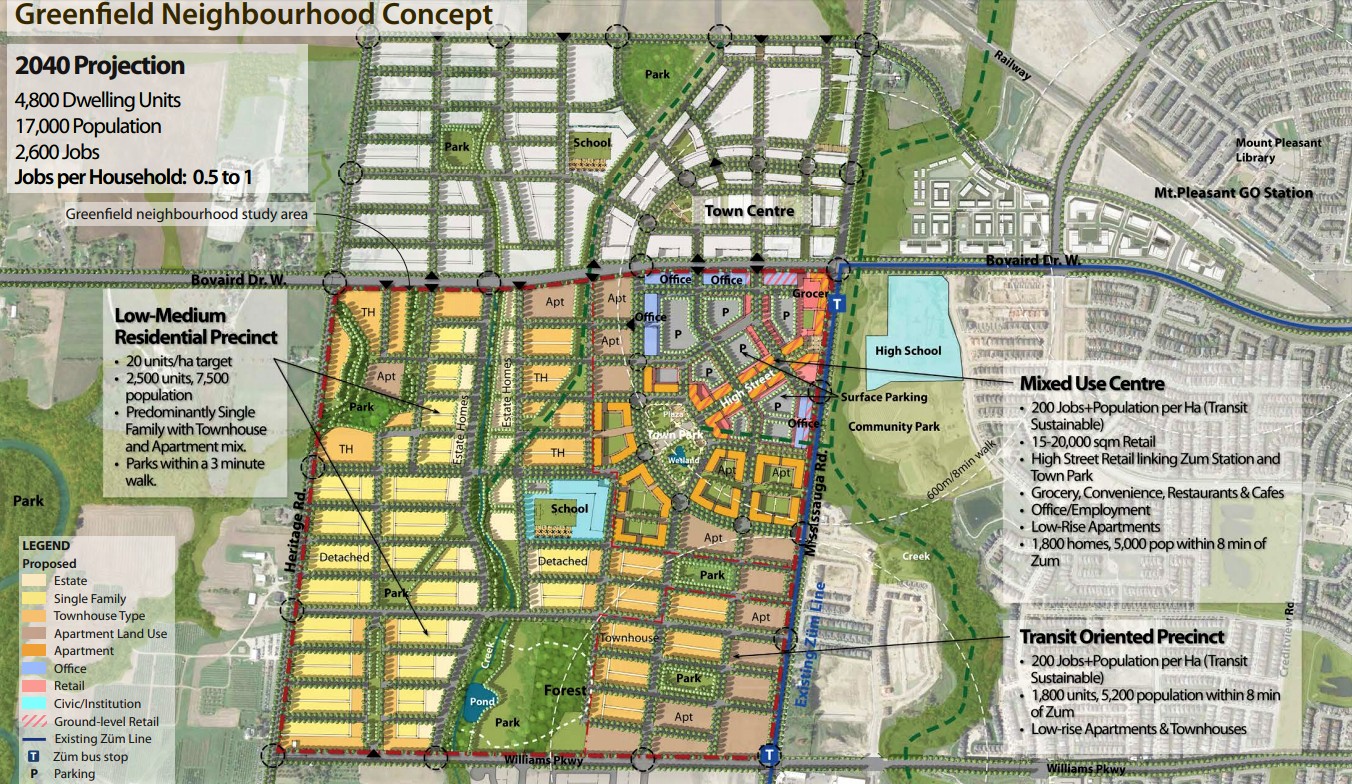
From the 2040 Vision document, this dense, complete community concept for one area within Heritage Heights cannot be achieved with the now selected 413 highway route running right down the centre of the coloured area of this map
On the day it was voted for, The Pointer asked the province if the City’s Council-approved Heritage Heights plan with its boulevard design instead of a highway, complies with the Ontario government’s requirements.
“Our preliminary review of the proposal put forward suggests that the proposed roadway design is not compatible with the Province’s functional and operational objective for the GTA West corridor,” the provincial Ministry of Transportation responded, on August 5.
“The proposed GTA West transportation corridor will be a Provincial 400-series highway with an adjacent transitway facility. The corridor must meet Provincial standards for design and operating speed, access, interchange design and separation, and other 400-series highway geometrics in order to provide for Provincial transportation needs,” a ministry spokesperson stated in an email to The Pointer.
The Pointer asked the City of Brampton to respond to the province's position that the boulevard design is not compatible with provincial requirements.
It’s unclear if the City was aware that its Heritage Heights plan centred by a boulevard design instead of a dissecting highway, was not compatible with the province when staff first explored the concept. The Pointer asked staff to explain why it went forward with such a large undertaking for one of the largest urban plans in the city’s history, even though the central feature of the plan is not allowed.
“The GTA West Corridor project, first launched in 2005, reflects a conventional transportation approach that has typically resulted in urban sprawl and contributes to additional congestion,” City of Brampton spokesperson Megan Ball responded after consulting with staff.
“Since 2005, Brampton’s population has increased by more than 30 per cent and the city continues to be one of the most rapidly growing cities in Canada. It has been proven that the most effective approach to reducing congestion is to concentrate on smarter land use approaches. The Heritage Heights plan focuses on compact, mixed-use development adjacent to higher order transit, while at the same time creates a far more robust street network to spread vehicular trips, provide multiple routing options, and, overall, develop more livable and complete communities.”
The City of Brampton wants this boulevard design shown in its rendering of Heritage Heights instead of a 400-series highway:
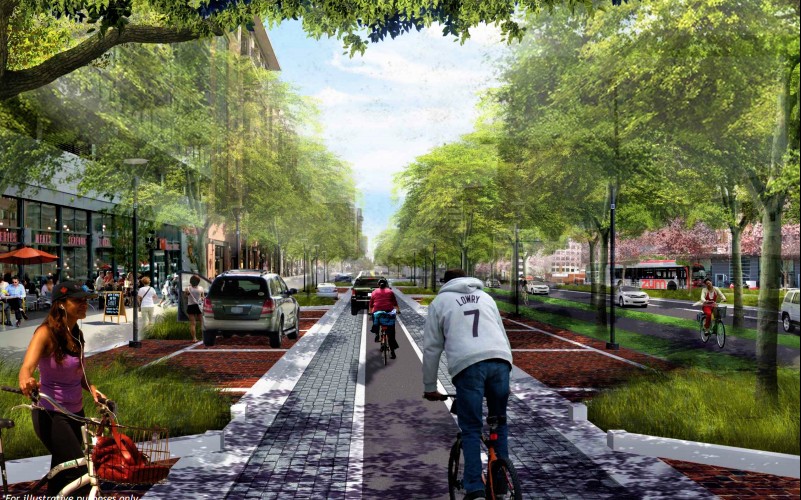
The PC government wants this:
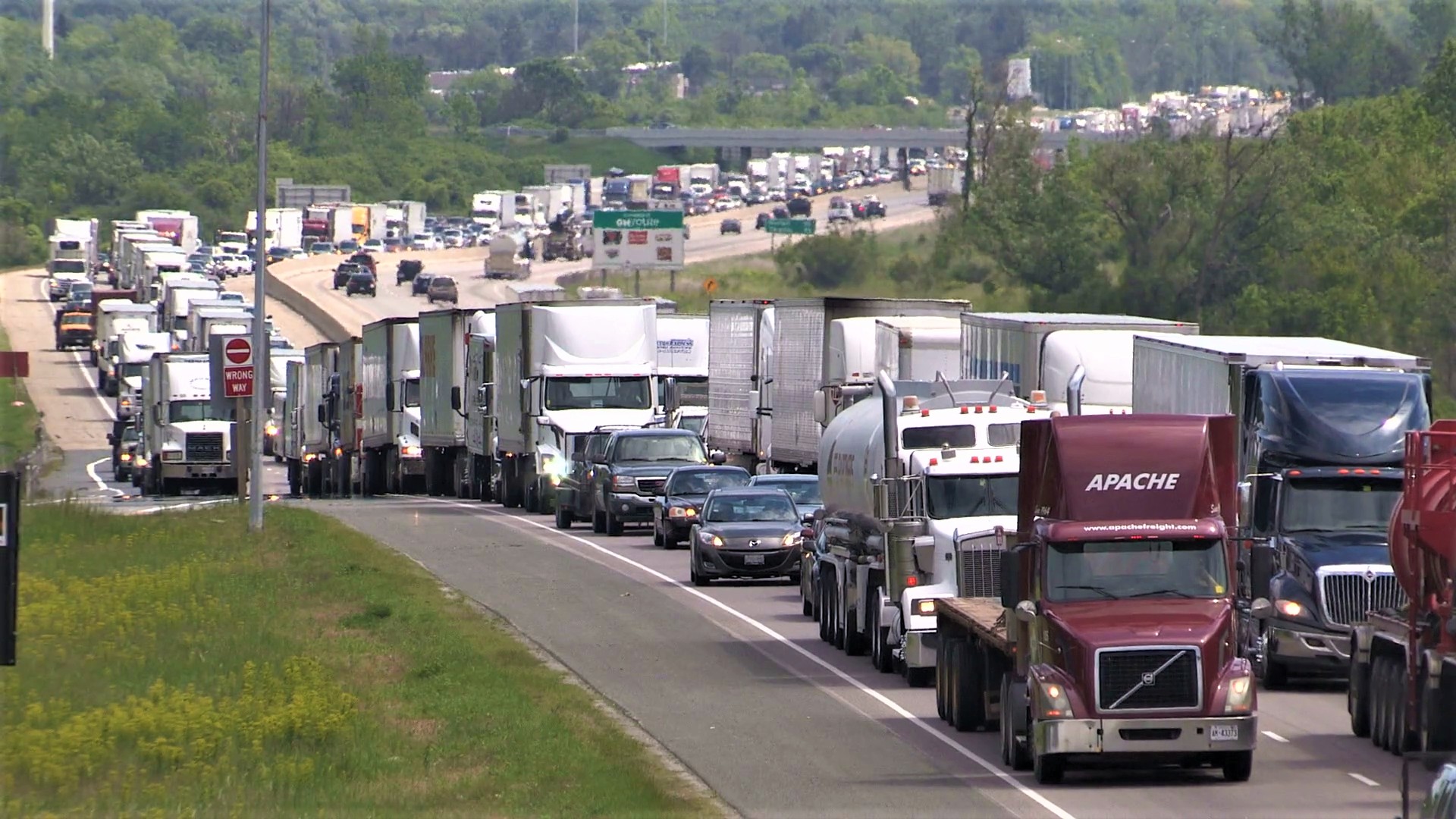
The City’s response, which suggests it is not in favour of the province’s intention of running a massive conventional 400-series highway all the way up Brampton’s western side, states its boulevard design “represents more than three times the development potential and job creation than would exist with a 400 series highway bisecting the area. The concept plan endorsed by Council is more successful at maximizing value creation and contributes to a more sustainable financial position for the city, region and province.”
The Pointer this week reached out to the City’s Chair of planning, Councillor Martin Medeiros, to find out why Council endorsed a plan not supported by the province, whether or not consultation with Queen’s Park was done early on so both parties would be on the same page and what his response is to the ministry’s rejection of the Brampton plan. He did not respond.
The Ford government has been widely criticized for pushing ahead with the GTA West Highway, after it was scrapped by the previous government for being environmentally dangerous, a sure-fire catalyst for more sprawl and congestion that will skirt the protected Greenbelt, and because it contradicts smart growth legislation passed by the province over the last 15 years.
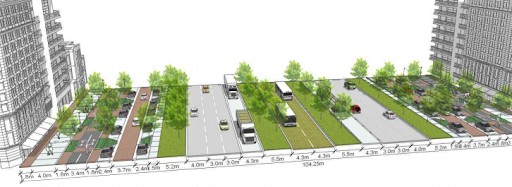
What the City's Heritage Heights boulevard would look like instead of a highway
“Ontario does not need another 400-series highway,” Environmental Defence stated in a press release August 7, the day the province announced its preferred route for the GTA West Highway. “This destructive plan will destroy communities, damage the environment, and deliver essentially no benefit to commuters.”
The organization reminded residents that “An expert panel appointed by the provincial government determined in 2017 that ‘a proposed highway in the GTA West corridor is not the best way to address changing transportation needs.’ Their modeling showed that the proposed Highway 413 would save drivers a mere 30-60 seconds per vehicle trip.”
“Meanwhile, the 170 metre-wide corridor would see a strip of concrete and asphalt rip through the Greenbelt in Vaughan and across the Whitebelt in Caledon and Brampton, and pave over a couple thousand hectares of prime agricultural land. It would also cut through the headwaters of the Credit and Humber Rivers, crossing rivers and streams approximately 53 times all told.”
Environmental Defence said, “The highway would cause more urban sprawl, put more cars on the road, and lead to more carbon pollution and air pollution in the communities through which it would pass.”
It’s unclear why City of Brampton officials, including its council members, have been largely silent on the issue since the Ford government took office in 2018, after he made clear that if elected the GTA West Highway would be pushed forward.
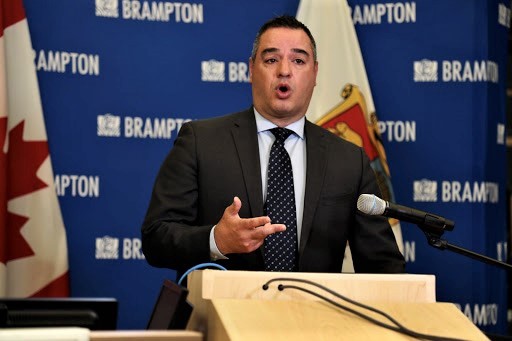
Councillor Martin Medeiros is Chair of the Planning Committee
Since then, council voted unanimously to support the PC government’s plan to restart the environmental assessment for the GTA West Highway and Mayor Patrick Brown has said he wants to see the highway built as he believes it's key to attracting employment. He has not explained how it will attract the type of high-return, white-collar jobs that Brampton desperately needs, instead of more warehouses and fulfillment centres along transportation corridors that clog the city’s roads with trucks, employ a small number of workers who are mostly paid lower-wages, while contributing very little to the property tax base for the amount of land these operations gobble up.
In the press release announcing Council’s approval of the Heritage Heights design and its boulevard feature, Brown said, “Creating complete, sustainable and connected communities that allow residents to maintain a high quality of life is a priority for City Council and is essential in helping us achieve our Brampton 2040 Vision. As Brampton’s last undeveloped area, Heritage Heights is an exciting opportunity to make it right from the start.”
It's now unclear how the mayor and the rest of Council will get the “complete, sustainable and connected communities” elected officials have claimed to support, when the City admits the province’s intention for the mega-highway will “bisect” the entire area, creating “urban sprawl and…additional congestion.”
Email: [email protected]
Twitter: @JoeljWittnebel
COVID-19 is impacting all Canadians. At a time when vital public information is needed by everyone, The Pointer has taken down our paywall on all stories relating to the pandemic and those of public interest to ensure every resident of Brampton and Mississauga has access to the facts. For those who are able, we encourage you to consider a subscription. This will help us report on important public interest issues the community needs to know about now more than ever. You can register for a 30-day free trial HERE. Thereafter, The Pointer will charge $10 a month and you can cancel any time right on the website. Thank you.
Submit a correction about this story


